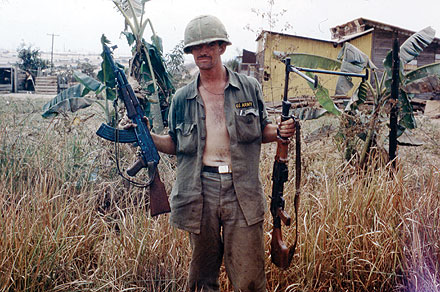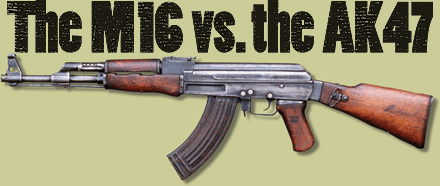 |
||||||||||||
|
March/April 2015
BY JOHN E. McDONALD Grunts like things simple. Generals love to plan and complicate matters. Generals seldom go to reunions. I’m sure it’s because the grunts would tell them their plans were no good. Mikhail Kalashnikov died in December of 2013. This man liked things simple. He fought in World War II. A little guy, he fit in a Russian tank. Mikhail was severely wounded but made it to a hospital. While there, he listened to fellow patients wonder why their weapons were not better made. The idea of a better battle rifle was born. Heart and soul, this was a fighting man who had seen battle close up and knew what a grunt needed. Growing up, our parents scared us saying, “Eat your vegetables; folks are starving all around the world and it could be you.” The nuns did a better job; their terror stories turned the boogie man into a harmless punk. The religious folks made sure that fighting the devil or your country’s battles was not only right, but would help save you from temptation. My terror meter was installed early and polished to perfection before I ever saw my first drill sergeant. Mikhail’s AK47 lost out to the SKS rifle. The AK47 battle rifle and the SKS rifle both fired the same cartridge, 762 x 39. I eventually met both of these weapons being used by some highly skilled folks in a far-off land. I joined the Army in 1968. The recruiter in Buffalo lied to me: 11 Bravo was not a cool military occupation skill to have. Basic training had some good points. For instance, on the rifle range I was always selected to fire up the extra ammo. “Where’s that 11 Bravo? Give him some more practice.” Hey, I was able to fire expert with the M14.
Standing in line at the replacement center in Vietnam, I realized that the Army was out of control. “11 Bravos to the front of the line. Line up before your initial on those poles.” That’s when I heard my first real war talk: “Electric Strawberry lost 60 yesterday, send ’em 50; 1st Cav got in the shit, send ’em 110. They need door gunners, too; they don’t last long.” My turn finally came, and I was checked off the list and given a piece of paper that said 199th Light Infantry Brigade. Since it was the middle of the night, we were shoved off to the mess hall in the pouring rain for a paper plate of green eggs and burnt toast. I asked everybody where and what is the 199th? A dirty KP asked for a smoke and a light, laughed, and said, “Oh yeah, those guys are called Redcatchers; they’re guarding the Navy and even get weekends off.” I almost skipped out of the mess hall thinking about my first letter home and telling my dad I was guarding the Navy. Two weeks later I didn’t believe anything. The jungle was hot, wet, and dark. The NVA and VC had no television; their entertainment was us. Several guys in the platoon, not just me, had sunglasses. Never wear sunglasses in the jungle. You walk into things, you fall down, you hurt yourself, and your cool blue square John Lennon sunglasses get thrown away. You’re resupplied every three days; c-rats for sure, clean dry socks if you’re lucky. We had humped to a road, and trucks were on the way. We were hoping for mail, not more bullets. I saw my first Green Berets in action. A beat-up Jeep came flying to a stop and two buck sergeants jumped out looking for our CO. The sergeants showed the captain their map and borrowed twenty bucks. They were on their way to Xuan Loc. They promised to bring back cold beer. The coolest thing for us grunts was that the two were wearing .45 pistols and carrying AK47s. It was my first up-close look at what the enemy was using. Our Platoon Daddy, Fast Eddy, told us those guys were showboats and liars. We didn’t believe him until resupply was over and we were humping back into the jungle; the Jeep had not returned with cold beer. Platoons rotate walking point. Second platoon had point, and we were looking for a stream and the bunker complex that was supposed to be along it. I was fighting a leech that was stuck behind my ear when everyone around me disappeared. The noise was terrific. I forgot the leech; everyone was yelling, “Get down, asshole!” I buddied up next to a large tree and fired a magazine on full auto into the shadows. I stuck my head up to see what I had hit and three distinct cracks went right by my ear. I was pissed and turned further around. “Smithy, you’re shooting at me, asshole!” He laughed and slammed another magazine into his M16. “Oh, no, I’m not—that’s Charlie.” My terror meter went into orbit, my brain bucket fell off, and I started yelling and firing magazines as fast as I could. Somebody kicked my ass—I think it was Fast Eddy—and told us to cease fire. Nobody was hit, and we drained canteens listening to the artillery come in.
I had to keep shaking my head to get my hearing working the way it should. I picked up six empty magazines; I didn’t remember firing so many. I did not want to go out and police up bodies; I wanted to go home. We had to get in line and move forward. Fast Eddy slapped me on the back. “Good job, newbie!” My terror meter dropped a little. Of the hundreds we killed, we found no trace—not even a blood trail. We did find a sandal, an empty sardine can, lots of fired up brass, and two AK47s. A side effect of this firefight was that the punk was scared right out of me. We air-mobiled into the nearest firebase and got a hot meal. It was then I finally got my hands on Mikhail’s product. Grunts love simple stuff, and the AK47 was all of that and more. In minutes, I had that rifle apart without a manual; it was designed that way. As I was putting it back together, Fast Eddy walked by and I asked if I could trade in my M16 and carry the AK. He stopped eating from his paper plate and told me I would be too dangerous. Grunts never understand lifers. There was plenty of ammo lying around, so I filled all three magazines. They were thirty-round magazines; we only had the twenty-round magazines for our M16. Too Low and Smithy sat down and explained that the NVA never cleaned their rifles. “Nope, they just dip them in diesel and oil, shake them off, and they’re ready to go. God’s honest truth.” I had taken it apart but hadn’t cleaned it, so I went over to the Cavalry guys working on an APC and dipped the AK into the vat of diesel they were using to clean parts. The damn stuff stinks, and I was glad I did not have my shirt on and have to walk around with that stench on me.
Up on the berm of the firebase I yelled, “Fire in the hole!” and loaded a full magazine into the weapon. Dripping diesel and oil, on single shot, the AK was hitting everything I aimed at. The rifle was warmed up, and I loaded the second magazine, looked over my shoulder, and warned my buddies, “I’m going full auto, so watch this.” I did it John Wayne style from the hip. The AK47 on full auto rides up and to the right; your target needs to be close if you want to hit anything. Hot oil and diesel stick to your skin, and they make your hair smoke if you’re not wearing your helmet. Its a very fast firing rifle; it continues to smoke even when empty and dropped—and so does the grunt. I had never entertained a crowd before. This is the only time in my Army career that I ever saw my Platoon Daddy laugh. In fact, the El Tee was crying, but he asked nicely if I could do it again. My respect for what the enemy was using was high. Now I knew this was no game; the enemy had good stuff. Kalashnikov designed a kick-ass, simple rifle that is still in use today. Our troops from Iraq to the Stan and beyond face this rifle every day. The experts all agree: Bury your AK47 and some ammo, and ten thousand years from now it will still work. I like to take my old rifles to the range. It’s a great way to meet other veterans. You fire that AK47 or your SKS and the next thing you know you’re talking to folks who say things like, “Oh man, the last time I heard that sound was at Quang Tri, Khe Sahn, the Mekong Delta, Baghdad, Somalia, the Stan.” The Colt made everyone equal, but Mikhail Kalashnikov with his AK47 got the advantage and respect. I’ll just bet that when Mikhail got to Valhalla, Patton shook his hand and said, “Good job.” When my life is over, I can only hope for the same.
|
||||||||||||
|
|
||||||||||||
|
||||||||||||
8719 Colesville Road, Suite 100, Silver Spring. MD 20910 | www.vva.org | contact us |
||||||||||||












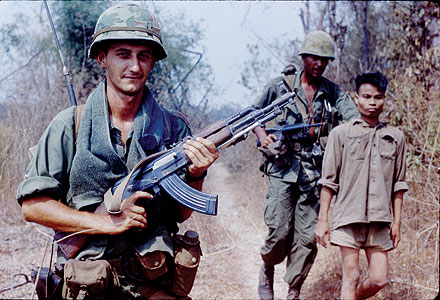

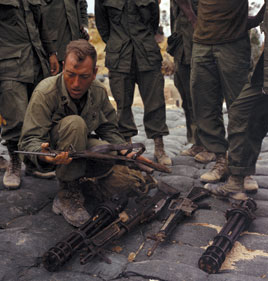 Pouring coffee for drill sergeants during KP, I first heard “Kalashnikov” and “AK47.” While running around in Georgia, my buddies and I just knew that the drill sergeants were lying to us, making us carry all that gear on our backs. We had to double-time all the way to the post theater and pay a quarter to watch John Wayne in the Green Beret movie. You guessed it: The green beanie recruiter was sitting right outside the theater promising Smoke Bomb Hill and Ft. Bragg for anybody interested in being just like John Wayne. I almost signed up until he said I would be a medic. By the time I was done with my training, the war would be over.
Pouring coffee for drill sergeants during KP, I first heard “Kalashnikov” and “AK47.” While running around in Georgia, my buddies and I just knew that the drill sergeants were lying to us, making us carry all that gear on our backs. We had to double-time all the way to the post theater and pay a quarter to watch John Wayne in the Green Beret movie. You guessed it: The green beanie recruiter was sitting right outside the theater promising Smoke Bomb Hill and Ft. Bragg for anybody interested in being just like John Wayne. I almost signed up until he said I would be a medic. By the time I was done with my training, the war would be over. 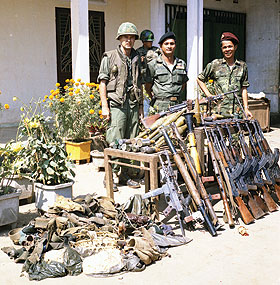 Grunts never exaggerate, so I thought Smithy was a little low in his estimate of the hundred or so that we had killed. “Too low,” Tupelo and Smithy both told me. “Oh yeah, we saw the muzzle flash; another inch or two and Charlie would have blown your head clean off. We got ’em as soon as the arty stops. We’ll show ya.”
Grunts never exaggerate, so I thought Smithy was a little low in his estimate of the hundred or so that we had killed. “Too low,” Tupelo and Smithy both told me. “Oh yeah, we saw the muzzle flash; another inch or two and Charlie would have blown your head clean off. We got ’em as soon as the arty stops. We’ll show ya.”